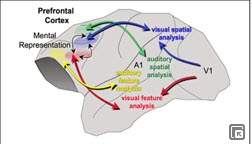Teaching in a language school has always made me sensitive to how people communicate and develop interpersonal relationships. The other day I walked into the lobby of my school and noticed the receptionist was staring at her computer screen. Hypnotized by what she was looking at, my hello got no reaction from her. I then made my way into one of the school administrative offices to enquire about a class I was organizing, I was greeted by another group of people working at their desks staring intently into their computer screens…One or two mumbled a ‘bonjour’ (remember I’m in France…not always known for their ‘warm’ welcomes…) but no one tore their eyes away from the screens that were bedazzling them. I was astounded. Not only did I feel that it was rude and inappropriate, but I also felt it was out of synch with what I have always tried to teach in my English classes…good communication practices.
Many communication experts have stressed that we communicate more with our body and facial language than with words. Of course body language can be cultural and sometimes we need to relearn how to interpret expressions and gestures. But there are some universal truths…a smile and eye contact can go a long way to making you feel warm and welcome. When I got back to my own computer, I looked up some want ads for receptionists. I found one that read like this: “Wanted/Receptionist for Hi-Tech Communications Company: The Receptionist “The Receptionist is responsible for creating a warm, responsive interaction between the facility and customers, meeting specific…, sensitivity…”A Receptionist ensures that customers receive courteous and prompt services…” Wow…am I living and working in the same world?
And then I began to think of how communication works. We first view others through our eyes. Our eyes are the windows to the prefrontal cortex of our brain which governs behavior and our socialization process and without using them we are cut ourselves off from the rest of the world. Of course if we are blind, we have to rely on other sensory organs such as our ears and hands to communicate our feelings and thoughts. I often tell my students that the first thing they have to learn is how to “act” in English…that is to say…communicate with their body. You can read more about this theory in a book entitled The Theater Arts and the Teaching of Second Languages by Stephen M. Smith. But if students are to learn how to “act” in another language, they need to watch others, preferably native speakers, “communicate” in English. And if those others are staring at a screen…
Interestingly enough, Montana State University Neuroscientist, with Marc Zirnsak and other neuroscientists from the Tirin Moore Lab at Stanford University have published a paper in Nature Magazine describing their research into how our vision stimulates the neurons in our prefrontal cortex (the most evolved part of our brain) which enables us to capture sensory information which is crucial to adaptive behavior. It also regulates our emotions and helps us to develop our personalities. ( Neurosciences.com).  Those who have studied psychology and the different parts of the brain have read stories of how damage to the prefrontal cortex (located in the very front of the brain just behind the forehead), the part of the brain which diffuses the information we receive through our eyes, can affect people’s behavior. Despite having normal intelligence and cognitive reactions, these people never learn complex social conventions and moral rules. When learning another language and culture, we need to learn new social norms and behavior in order to communicate. According to the scientists, the study offers evidence neurons in the prefrontal cortex of the brain start processing information anticipating the social response that is required in a given situation. This is probably why images have far more impact than words which we need to process differently. But if we never look up?
Those who have studied psychology and the different parts of the brain have read stories of how damage to the prefrontal cortex (located in the very front of the brain just behind the forehead), the part of the brain which diffuses the information we receive through our eyes, can affect people’s behavior. Despite having normal intelligence and cognitive reactions, these people never learn complex social conventions and moral rules. When learning another language and culture, we need to learn new social norms and behavior in order to communicate. According to the scientists, the study offers evidence neurons in the prefrontal cortex of the brain start processing information anticipating the social response that is required in a given situation. This is probably why images have far more impact than words which we need to process differently. But if we never look up?
To prove my point, I’d like everyone who hasn’t seen it to watch Gary Turk’s Youtube video entitled (appropriately) Look Up! (over 44 million views so far):
And of course I will take this opportunity to mention Kyu Sakamoto, a Japanese singer and actor (坂本 九 Sakamoto Kyū?, born Hisashi Oshima (大島 九 Ōshima Hisashi?), 10 December 1941 – 12 August 1985),who sang the International hint song “Sukiyaki” or “Look Up”, which was sung in Japanese and sold over 13 million copies in 1963. For the first time in history, a Japanese song was on the list of the Billboard Hot 100 in June 1963. Tragically he died on August 12, 1985, in the crash of Japan Airlines Flight 123, probably the deadliest single airplane accident in history. Here it is for those of you who have never heard it before (you may even learn a little Japanese!):
Soyonara Kyu!

